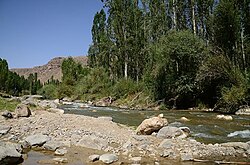| Zola River | |
|---|---|
 | |
| Location | |
| Country | Iran |
| Province | West Azarbaijan province |
| Physical characteristics | |
| Mouth | |
• location | Lake Urmia, Iran |
The Zola River, also known as the Zola Chai is a river in Iran, flowing into Lake Urmia. It runs north of Urmia and west of Salmas city in West Azerbaijan province. Rising in the mountains along the border with Turkey, the Zola flows southwest along the Salmas Plain. The river has a catchment area of 846 km². [1]

